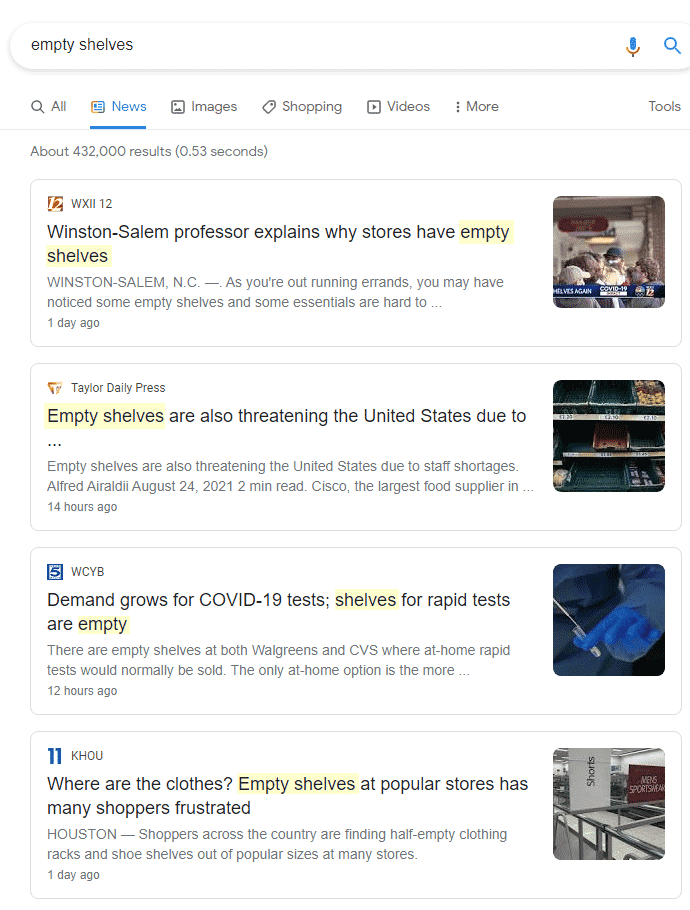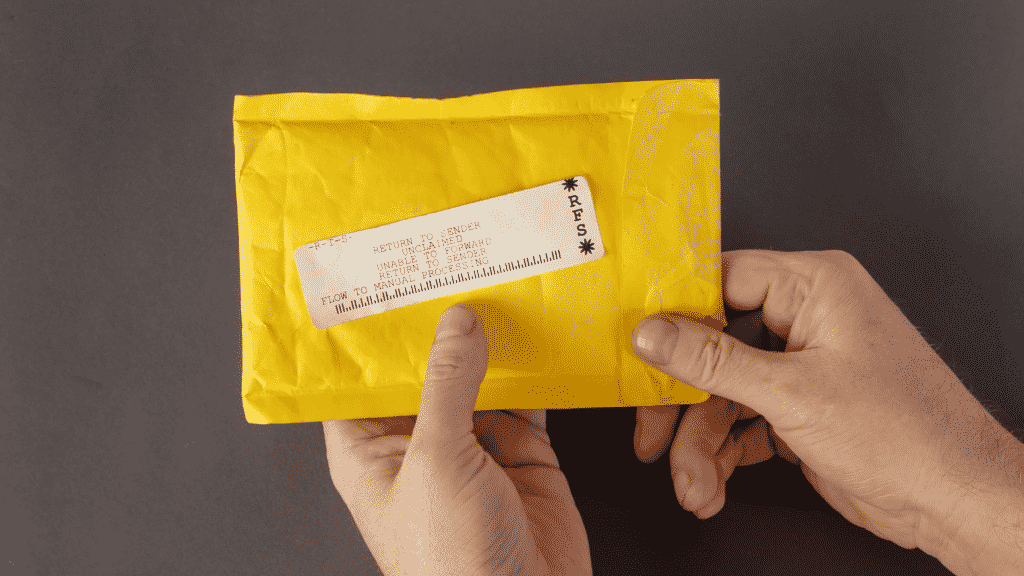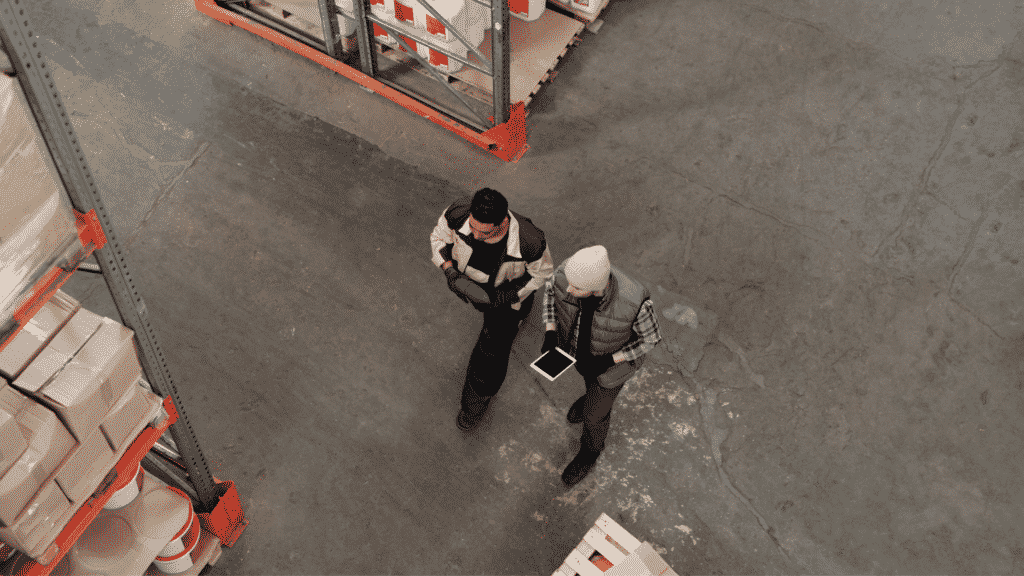Empty shelves at the grocery store. Amazon listings that say “we don’t know when or if this item will be back in stock.” How many of these have you seen lately? It’s happening to me more and more often, and I say to myself, “what a failure in inventory optimization!”
OK, sure, I don’t see things like most people. I do, after all, write for a shipping company’s blog!
However, a quick Google search shows that I’m not the only person who has noticed this trend lately. Odds are, if you run a business, you don’t want to show up in headlines like this…

Running out of stock is really bad for business. So is holding onto too much stock. Finding the balance between the two is one of the hardest things that a business can do.
So let’s talk about how you can do that.
What is inventory optimization & why does it matter?
Recently, we talked about inventory management in general. This is the process by which you track where products are, where they’re going, and when to order more.
It’s a simple concept, but hard to do well. Order too much and you tie up your capital and risk running out of space, holding onto deadweight items for far too long. Order too little and you run out of stock, lose revenue, and risk lowering your customer retention rate. It’s a tricky balance!
That’s where inventory optimization comes in. It’s how you decide how much inventory to keep so that you always have enough inventory to meet customer demand, without having so much it drives up cost.
The prizes for doing this well are manifold. You avoid stockouts, which means steadier sales and fewer business interruptions. This, in turn, improves your customer experience and increases customer retention. This leaves you with more revenue and a better reputation.
Meanwhile, inventory optimization keeps you from ordering too much inventory. That keeps your expenses in check, reduces waste, saves physical space, and helps you avoid holding onto inventory that won’t go anywhere.
Of course, finding this kind of balance is difficult and requires careful thought, experimentation, and practice. For that reason, we have provided 11 tips to help you get started!
Inventory Optimization: 11 Tips to Stay Stocked & Profitable
1. Develop and monitor metrics.
“What gets measured gets managed.” Inventory is no different. Before starting any serious project to optimize inventory practices, it helps to define a few metrics to track success. Here are five worth tracking:
- Inventory turnover. This is the cost of goods sold divided by average inventory. Low turnover indicates you have too much stock, and high turnover means you might not have enough.
- Gross margin percent. This is how much revenue turns into gross profit. Weak margins mean you need to raise your prices or cut your costs.
- Order fill rate. This is the number of orders that your customers receive on-time. You want this to be as close to 100% as possible.
- Cost of carrying. This is the percentage of money that is spent on inventory overhead per year. That includes storage, fulfillment, disposal, shrinkage, and other carrying costs. If this metric is too high, you need to figure out what’s driving it up and fix it.
- Days to sell inventory. This is the average amount of time it takes for inventory to be purchased. If you find yourself holding onto inventory for too long, especially perishable inventory, then you need to keep less in inventory.
2. Always keep some safety stock on hand.
Once you have a general sense for how your inventory is being managed, there is one thing you can do that will have a near-immediate positive impact. Always keep safety stock on hand.
Yes, you don’t want to keep too much inventory as that will drive costs up. However, unless you’re working with perishable goods, you want to err on the side of having a little too much inventory instead of not enough inventory.
Throughout the 2010s, the gold standard was the lean supply chain. The idea was that you always had just enough inventory to stay afloat. However, the COVID-19 pandemic revealed the fragility of the lean supply chain system. As a result, many companies, including the famously lean Toyota, are starting to keep more inventory on hand. You should follow suit.

3. Spend time optimizing your demand planning.
Inventory optimization depends upon being able to predict with reasonable accuracy what people are going to order and when. Believe it or not, consumer behavior is predictable enough to allow for demand planning, if you know what you’re doing.
This is a pretty complicated subject, so we recommend you read our full demand planning guide. In short, you will want to account both for your company’s sales history, as well as product lifecycles, seasonality, trends, and marketing initiatives. When considering all these factors together, you can often get a reasonably good idea of how much inventory you need to keep on hand.
4. Figure out what sells quickly and what sells slowly.
Some inventory sells within a week of order. Some inventory doesn’t get ordered very often. It’s important to know which of your inventory moves quickly so that you can keep more of it on hand. Slow-moving products may be necessary to carry, but you want to make sure that you don’t have too much on-hand since you have a lot more notice before you run the risk of stocking out.
5. Establish par levels to optimize stock replenishment timing.
After you make sure that you have some safety stock on hand, it’s smart to standardize that. This is where par levels come in. This is a minimum amount of product that you always keep on hand at all times.
Establishing par levels is important because it helps you know when to order more inventory. Once you get a feel for the rhythm of your inventory’s movement, you can time stock replenishment to arrive at approximately the time when you inventory is about to dip below par level.
Par levels are also flexible too. You can decrease par levels when replenishment is quick and easy and increase par levels during times of shortages and delays.
6. Make sure you have enough space.
This may seem obvious, but it’s really important. If you don’t have much space available, you have two broad options.
The first option is to keep smaller inventories and order replenishment inventory more often. This saves space, but the cost of frequent, smaller bulk reorders may add up.
The second option is to outsource inventory storage and order fulfillment to a third party. This is what we do at Fulfillrite. This is an effective and cost-efficient way to free up space and eliminate the work of order fulfillment at the same time.
7. Store commonly paired items close to one another.
As a general rule, complementary items should be stored close to one another. Numbers in a system, especially with par levels attached, can help you know when to reorder certain items. However, there is still a benefit to keeping certain items in physical proximity. If you sell laptops, the charging cables should be stored right next to them. That way, if you are running low on charging cables, it is obvious from looking at them that you need to place a reorder.
This is a good way of reinforcing strictly numerical data for inventory management with common sense and observation.

8. Have a reverse logistics plan.
No inventory optimization plan is complete without good reverse logistics processes in place. People will return items to you, especially if you’re running an eCommerce operation. This is inevitable.
Both for customer experience and for inventory management, you need to know what you will do with those items when returned. Will you put them back into stock as-is, toss them, or attempt to repair or refurbish and sell at a lower price?
Each of these options can be appropriate in certain situations. It’s important to make a case-by-case decision based on what is appropriate for your business.
9. Check received shipments to proactively spot damage and mistakes.
When receiving new shipments, it’s an inevitable fact that some percentage of what is created will be defective or damaged. If you can, try to proactively find and remove damaged items.
If that is not possible, the next best thing you can do is figure out what percentage of items is typically broken and factor that into your par levels and your returns management processes.
Don’t overlook this. Inventory optimization can easily be derailed if you keep 5% of inventory on-hand but 4% of an average shipment is defective!
10. Run clearance sales when space is tight.
Clearance sales are a great way to get rid of inventory that is weighing you down. Not only do you remove the initial problem of wasted space and deadweight inventory, but it can also be used as a way to generate revenue, retain current customers, and pull in new ones. For best results, clear out inventory during the slow season to kickstart sales when they wouldn’t otherwise be happening.
11. Use FIFO.
FIFO is short for first in, first out. It’s a good inventory management practice for everything from enterprise-level businesses to your own pantry and fridge. Make sure the oldest stock is always the first to go out the door. Even items that don’t technically perish will eventually break. It’s best to avoid having the same handful of units inventory collecting dust in the bottom of a bin somewhere in your warehouse.
Final Thoughts
With a little bit of thought and practice, inventory optimization is not hard to roll out. The benefits range from keeping expenses in check to keeping your shelves stocked no matter what. Putting even a few of these tips into practice can save you a lot of money in the long run!





